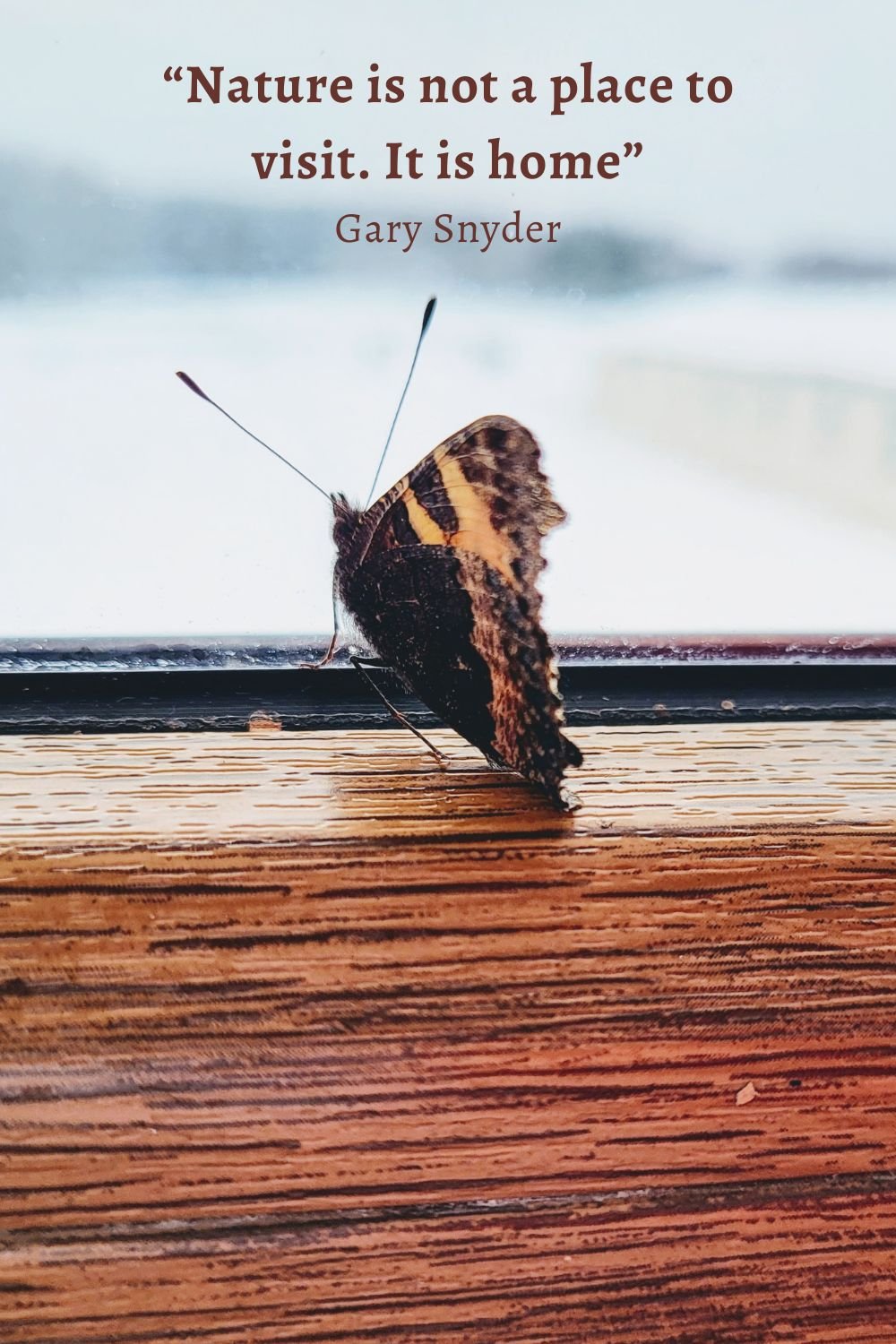
Throughout human history, people living in primitive societies have relied heavily on nature for their survival. From the earliest days of our species, humans have sought guidance and aid from the natural world. This trend is not restricted to a single culture, as different societies across the globe have a long history of seeking help from the environment around them (for example, Native American traditions, Australian Aboriginal traditions, Ayurveda in India, Shinrin-Yoku (Forest bathing) in Japan, Nordic traditions, Chinese medicine, and the Five elements, Maori Healing practices in New Zealand and many others). Natural healing has its origins in Indigenous wisdom and traditions. Whether for food, medicine, shelter, or protection, humans have always looked to nature as a source of aid and inspiration. This deep connection to nature has been a defining characteristic of human societies for millennia, and it continues to influence our relationship with the environment today.
In this article, I aim to compile information on the noteworthy theories and authors that have played a pivotal role in shaping Nature Therapy, also known as Ecotherapy and Nature-Based Therapy. I will delve into the explanation of Nature Therapy, differentiate it from Ecopsychology, and provide a brief overview of various research findings and the diverse types of Nature Therapy. It’s crucial to acknowledge that the recent introduction of Ecotherapy in modern science, alongside varying perspectives among specialists, particularly regarding Nature Therapy, Ecotherapy, and Nature-Based Therapy, might cause confusion. To ensure clarity in this article, I will treat terms such as Nature Therapy, Nature-Based Therapy, and Ecotherapy as synonymous.
Table of Content
- 9 Key Insights: Enriching Lives through Nature and Ecotherapy
- Shaping Nature Therapy (Ecotherapy): Exploring Influential Theories and Author Contributions
- Insightful Exploration: Understanding the Essence of Nature Therapy (Ecotherapy)
- Enhancing Well-Being: The Impact and Benefits of Nature Therapy (Ecotherapy)
- Examining the Therapeutic Potential of Nature Based Interventions on Mental and Physical Health
- Nature’s Healing Touch: The Role of Exposure in Reducing Pain Perception
- Nature’s Impact on Well-Being: Enhancing Life’s Meaning and Authenticity
- Nature’s Impact on Cognitive Functioning: Enhancing Mental Well-Being and Protecting Mental Health
- Understanding the Boundaries of Ecotherapy: Acknowledging and Addressing Limitations
- Exploring the Diversity of Nature Therapy: Understanding its Psychotherapeutic Essence
- Closing Reflection: Nurturing Bonds with Nature
- References
9 Key Insights: Enriching Lives through Nature and Ecotherapy
1. Biophilia Connection: The biophilia hypothesis highlights humanity’s inherent genetic need to connect with nature, shaping behavior and influencing the design of environments to enhance overall well-being.
2. Stress Reduction in Nature: Stress Reduction Theory emphasizes the calming impact of natural settings on mental stress, presenting nature as a key element in managing and alleviating stress.
3. Restoration of Attention: Attention Restoration Theory underscores the restorative benefits of spending time in nature, aiding in mental fatigue recovery and enhancing directed attention through key environmental components.
4. Ecopsychology and Ecotherapy Dynamics: Ecopsychology delves into our existing connection with nature, while Ecotherapy provides actionable strategies to enhance this connection, addressing both the current state and practical improvement.
5. Nature Therapy’s Holistic Approach: Nature Therapy serves as a structured psychotherapeutic tool to reconnect individuals with nature, promoting holistic well-being and emphasizing nature’s roles as Guide and Co-Therapist.
6. Clinebell’s Ecotherapy Framework: Clinebell’s ecological model offers a perspective on nature’s potential for healing and growth. By integrating inreach, upreach, and outreach, individuals can deepen their connection with the environment, fostering personal well-being and environmental consciousness.
7. Scientific Validation: A wealth of scientific studies strongly supports the idea that regular nature connection and engagement in ecotherapy contribute significantly to physical and mental well-being.
8. Mindful Consideration: Despite its promise, Nature therapy is a burgeoning field, and it’s crucial to acknowledge its newness and consider potential limitations, recognizing that not all nature activities may universally have a “healing” effect.
9. Diversity in Ecotherapy Practices: Ecotherapy offers a spectrum of practices, from relaxed to formalized approaches, adaptable to different levels, societal sectors, and scopes, ensuring inclusivity and diverse applications.
Shaping Nature Therapy (Ecotherapy): Exploring Influential Theories and Author Contributions
The biophilia hypothesis
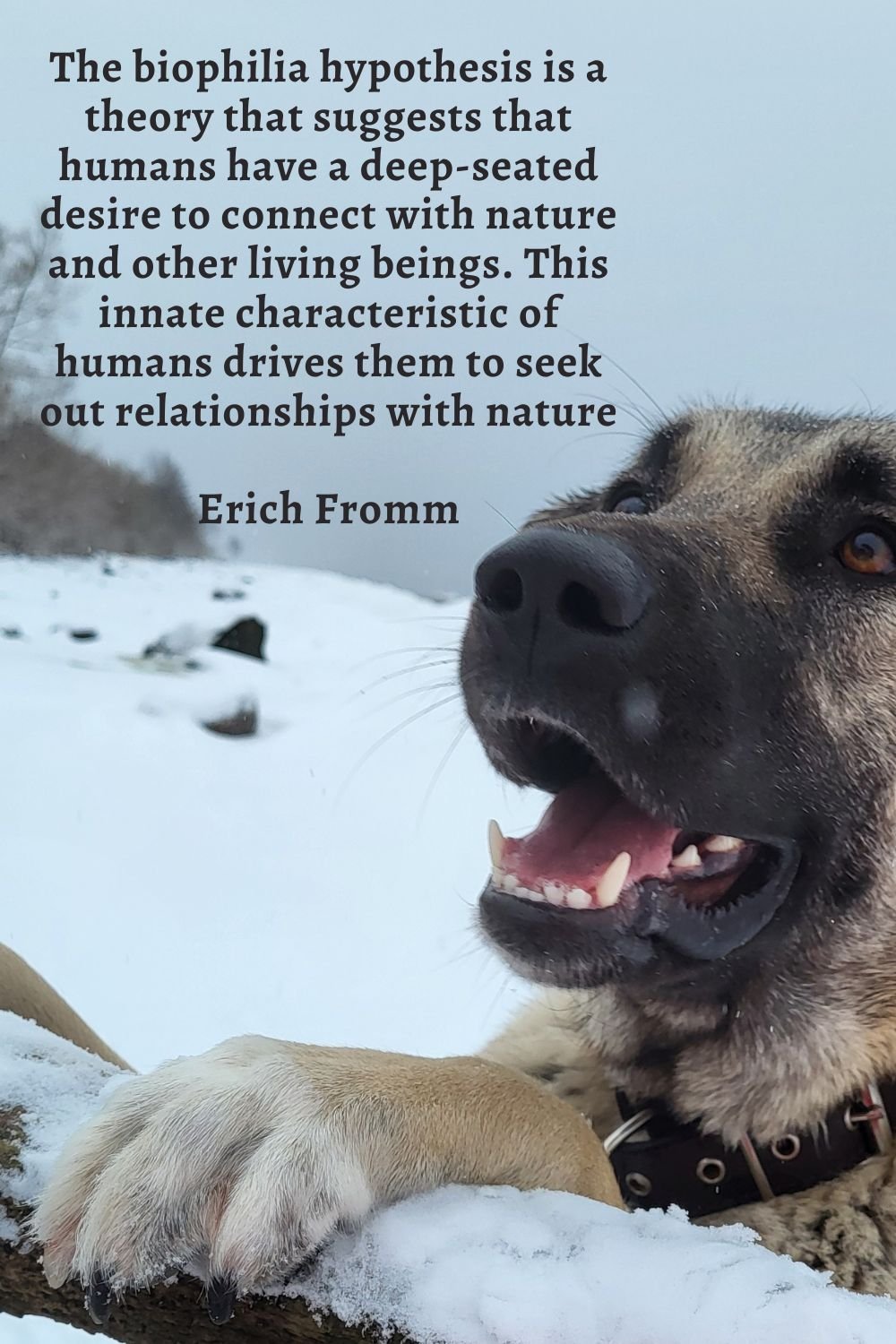
The biophilia hypothesis is a theory that suggests that humans have a deep-seated desire to connect with nature and other living beings. This idea was first introduced by Erich Fromm, a German-born American psychoanalyst, in his book “The Anatomy of Human Destructiveness” in 1973, where he defined biophilia as “the passionate love of life and of all that is alive.” Fromm believed that this innate characteristic of humans drives them to seek out relationships with nature. Later, American biologist Edward O. Wilson expanded on Fromm’s theories in his 1984 book “Biophilia”, proposing that humans have a genetic predisposition to seek out interactions with other living organisms. Wilson believed that this connection with nature is essential for our mental and physical well-being. The concept of biophilia has gained popularity in fields such as environmental psychology and landscape architecture, where it is used to inform design choices that promote human well-being. It has also been used to explain why people are drawn to natural landscapes, animals, and even urban green spaces.
The Stress Reduction Theory
The Stress Reduction Theory, put forward by Roger S. Ulrich, delves into the effects of natural environments on stress levels and overall well-being. This theory, proposed in the 1980s, posits that exposure to nature can have a positive impact on reducing stress and promoting healing. The primary study linked with Ulrich’s Stress Reduction Theory is the “View through a Window” study carried out in a hospital setting. Ulrich compared patients recuperating from gallbladder surgery who had a view of nature outside their windows with those whose windows faced a brick wall. The study found that patients with a view of nature experienced fewer complications, required less pain medication, and had shorter hospital stays compared to those with a view of the brick wall. Ulrich’s theory suggests that natural settings have a calming and restorative effect on individuals, leading to physiological and psychological benefits. The presence of nature, whether experienced directly or through views, is believed to reduce stress, promote relaxation, and contribute to the overall healing process.
The Attention Restoration Theory (ART)
The Attention Restoration Theory (ART) was proposed by Kaplan and Kaplan in 1989. This theory suggests that individuals can recover from mental fatigue and restore their ability to focus by spending time in natural settings. ART is based on two types of attention, namely involuntary and directed attention. While involuntary attention is automatic and effortless, such as being captivated by the sound of birds or the rustling of leaves in a forest, directed attention requires effort and concentration, as seen when working on tasks that demand cognitive effort and focus. ART posits that spending time in natural environments promotes the restoration of directed attention due to the rich stimuli present in natural settings that effortlessly capture involuntary attention. Thus, the brain can take a break from directed attention, leading to reduced mental fatigue and improved cognitive performance when returning to tasks that require focus.
The authors also identified the 4 components of restorative environments that contribute to the restoration of attention, information processing, and decrease of distress:
- Being away. Natural settings are often the preferred destinations for extended restorative opportunities. The seaside, the mountains, lakes, streams, forests, and meadows are all idyllic places for ‘getting away’. Yet for many people in the urban context, the opportunity for getting away to such destinations is not an option. However, the sense of being away does not require that the setting must be distant. Natural environments that are easily accessible thus offer an important resource for resting one’s directed attention.
- Fascination. Nature is certainly well-endowed with fascinating objects, as well as offering many processes that people find engrossing. Many of the fascinations afforded by the natural setting qualify as “soft” fascinations: clouds, sunsets, snow patterns, and the motion of the leaves in the breeze readily hold the attention, but in an undramatic fashion. Attending to these patterns is effortless, and they leave ample opportunity for thinking about other things.
- Extent. In the distant wilderness, the extent comes easily. But the extent need not entail large tracts of land. Even a relatively small area can provide a sense of extent. Trails and paths can be designed so that small areas seem much larger. Miniaturization provides another device for providing a feeling of being in a whole different world, though the area is in itself not extensive. Japanese gardens sometimes combine both of these devices to give a sense of scope as well as connectedness. Extent also functions at a more conceptual level. For example, settings that include historic artifacts can promote a sense of being connected to past eras and past environments and thus to a larger world.
- Compatibility. The natural environment is experienced as particularly high in compatibility. It is as if there were a special resonance between the natural setting and human inclinations. For many people, functioning in the natural setting seems to require less effort than functioning in more “civilized” settings, even though they have much greater familiarity with the latter. It is interesting to consider the many patterns of relating to the natural setting. There is the predator role (such as hunting and fishing), the locomotion role (hiking, boating), the domestication of the wild role (gardening, caring for pets), the observation of other animals (bird watching, visiting zoos), survival skills (fire building, constructing shelter), and so on. People often approach natural areas with the purposes that these patterns readily fulfill already in mind, thus increasing compatibility.
Ecopsychology
Even though ecotherapy has been influenced by ecopsychology, they are not used interchangeably. Ecopsychology (from Greek oik-, oiko-, from oikos “house”, psychē “breath, principle of life, life, soul,” and –logia (which comes from the Greek –logos) “speech, word, reason”) and ecotherapy are two terms that have some fundamental differences.
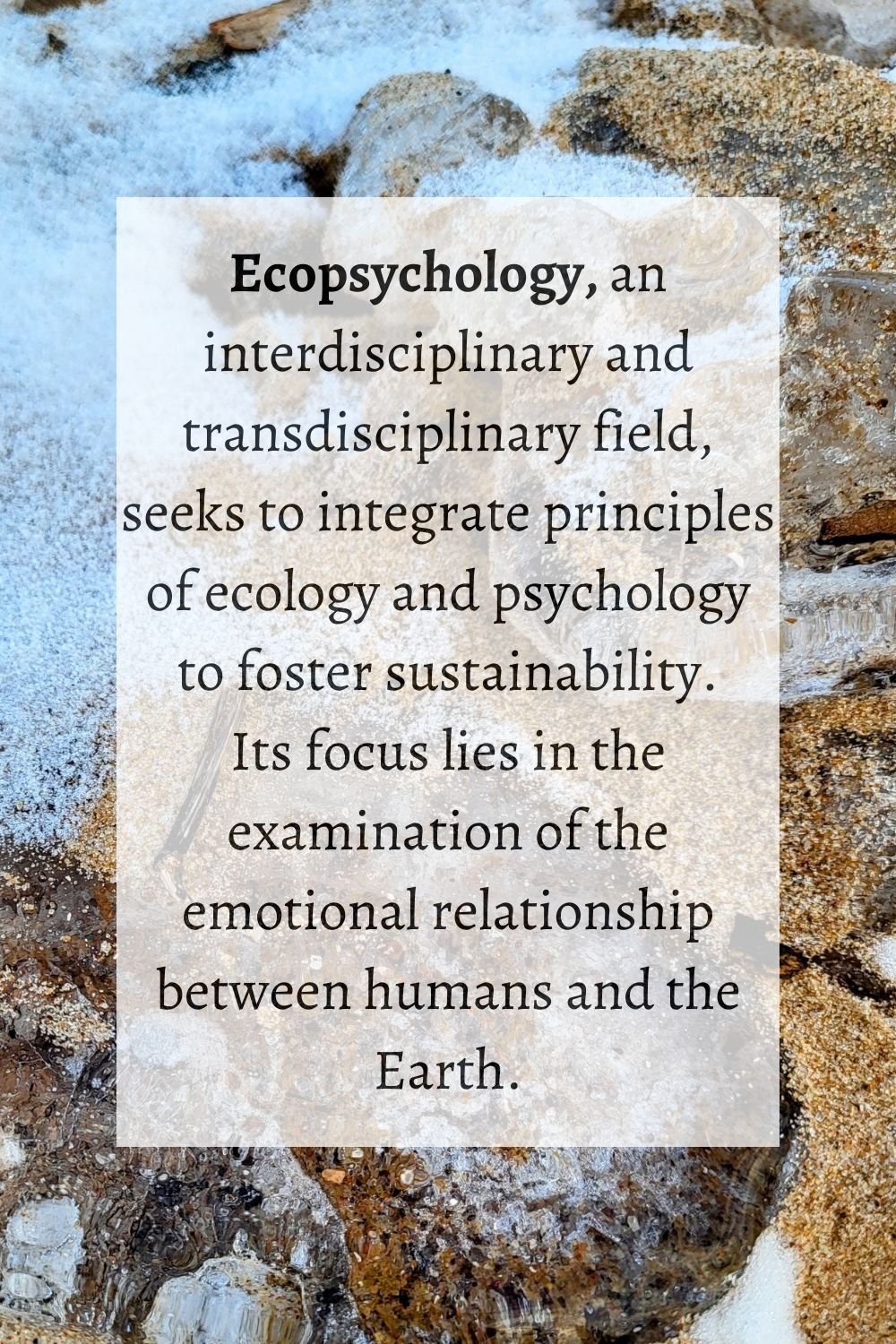
Ecopsychology is an interdisciplinary and transdisciplinary field that focuses on the synthesis of ecology and psychology while promoting sustainability. Theodore Roszak first introduced the term “ecopsychology”, which aims to bridge the gap between the ecological and psychological aspects. According to Roszak, it is essential to understand the needs of the planet and the person as a continuum. Psychologists Mary Gomes and Allen Kanner joined Roszak in calling for a “greening of psychology” by arguing that understanding our connection to the earth is necessary to understand ourselves. Some authors, such as A. Fisher (2012), believe that it differs from conventional psychology by studying the emotional bond between humans and the Earth, examining why people continue environmentally damaging behavior, and motivating them to adopt sustainability. It analyses personal pain in its wider connection to the more-than-human world, instead of solely considering it in the context of individual or family pathology. Other researchers, such as M.E. Delaney (2020), suggest that the primary objective of ecopsychology is to expand the discipline of psychology to understand better the interrelationship between humans and nature, as well as the adverse emotional consequences that result from the damage inflicted on the planet by humans. In summary, ecopsychology focuses on “what is”, while ecotherapy is known as the “how to” in our therapeutic connection to nature.
Insightful Exploration: Understanding the Essence of Nature Therapy (Ecotherapy)

Nature Therapy (also called Nature Based Therapy or Ecotherapy) is an umbrella term for a structured type of psychotherapy that aims to help a person reconnect and establish a healthy relationship with nature, to promote the well-being of both humans and nature.
Nature Therapy includes psychotherapeutic activities that are undertaken with an ecological consciousness or intent, often utilizing natural settings, activities, or processes as an integral part of the therapeutic process, focusing on ecological aspects of self, identity, and behavior at various scales, from personal to planetary (Doherty, 2016).
Nature Therapy is a “two-way street”, which means that it is important to promote the reciprocal relationship between humans and nature.
Linda Buzzell, a psychotherapist, ecotherapist, author, and ecopsychology educator, describes two levels of ecotherapy practice:
- Level One Therapies – can help clients reduce unwanted symptoms (e.g., depression, anxiety) and promote mental well-being, but these approaches essentially view the natural environment as a resource to be used for human benefit. They place the needs of the client at the center of their field of attention and disregard the needs of the environment as a whole.
- Level Two therapies – on the other hand, recognize that the well-being of humans is inseparable from that of the ecosystem. Human interests cannot flourish in isolation from the whole, so to use the Earth as a therapeutic tool without regard for the environment’s reciprocal needs is not only basically exploitative but also, ultimately, psychologically damaging. It mirrors attitudes that have caused so many of the problems that we are currently experiencing at a planetary level, which are also psychologically and physically harmful to ourselves and all species. Rather than viewing nature as a resource to be used for the benefit of the client, Level 2 approaches honor the systemic context and invite relationship and reciprocity rather than exploitation.
H. Clinebell (1996), a notable figure in the field of ecotherapy, posited that ecotherapy (from Greek oik-, oiko-, from oikos “house” and therapīa “curing” or “healing”) is a healing and growth process that is facilitated by a healthy interaction between individuals and their natural environment. Clinebell identified three key actions related to ecotherapy: inreach, upreach, and outreach.
- Inreach refers to the process of opening oneself to the restorative and nourishing power of nature.
- Upreach involves an energizing spiritual awareness that motivates and empowers individuals to engage in outreach.
- Outreach, in turn, involves the active participation of individuals with others in various initiatives to protect and conserve the environment.
Clinebell also emphasized that these three components – inreach, upreach, and outreach – work together synergistically to create an “ecological circle”. This ecological circle represents a healthy and mutually beneficial relationship between humans and the natural world.
Within the framework of Ecotherapy, Nature plays key roles as the Guide, Co-Therapist, or Ultimate Therapist, while the therapist functions as a guide, catalyst, or container. It is essential to highlight that, at present, there is no officially recognized therapeutic protocol for specialists, and there are no uniform criteria regarding their education and qualifications in this field.
Enhancing Well-Being: The Impact and Benefits of Nature Therapy (Ecotherapy)
Ecotherapy has been proven as a complementary approach to effectively alleviate symptoms of various mental difficulties and strengthen personal resources. It can be successfully integrated into other forms of psychotherapy and common treatment plans if needed. However, it is crucial to understand that ecotherapy cannot replace medication therapy or any treatment plan prescribed by a specialist doctor. It is essential to approach this issue responsibly and consult your doctor before making any changes to your treatment plan. In this section, I will briefly outline some recent conclusions that are currently being drawn in the field of science regarding exposure to nature, nature activities, and ecotherapy.
Examining the Therapeutic Potential of Nature Based Interventions on Mental and Physical Health
Engaging with nature has positive effects on both mental and physical health, according to a study comparing activities in natural and urban settings. The research measured stress levels in three environments: one resembling wilderness, a municipal park, and an indoor exercise facility. Using markers like cortisol and amylase, along with psychological assessments before and after the visits, the study found that spending time in natural settings significantly reduced both physical and psychological stress compared to urban or indoor environments (Ewert & Chang, 2018).
Another study, reviewing 31 research projects with 1842 participants, explored the impact of being in nature on stress relief. The findings demonstrated associations with decreased stress levels, including lower cortisol, reduced anxiety, self-reported stress, blood pressure, heart rate variability, and improved overall well-being. However, caution is advised in interpreting results due to varying study quality and differences between them. Further studies, especially using simulated or indoor settings, are needed to better understand the relationship between nature exposure and stress relief (Wenfei et al., 2021).
Research conducted in Brazil sought to understand how the frequency of contact with nature influences mental health. The study, involving 1186 participants, revealed that more frequent contact with nature was linked to a lower likelihood of stress, anxiety, and depression. Notably, the benefits were most significant when the contact occurred at least once or twice a week (Bressane et al., 2022).
Additionally, a recent study review highlighted Ecotherapy as an emerging psychotherapeutic technique involving nature-based interventions. Approaches like social and therapeutic horticulture, animal-assisted interventions, care farming, green exercise, and wilderness therapy have shown effectiveness in addressing various medical and psychosocial conditions, including hypertension, obesity, depression, stress reduction, PTSD, ADHD, and adjustment disorders. Researchers integrated ecotherapy principles into other psychotherapeutic techniques for enhanced efficacy (Chaudhury & Banerjee, 2020).
Nature’s Healing Touch: The Role of Exposure in Reducing Pain Perception
Exposure to nature or images of nature has demonstrated a correlation with decreased pain and pain perception in individuals undergoing medical procedures and during recovery. A study involving 61 individuals with chronic pain revealed significant reductions in pain and depression among those who participated in a two-day forest therapy program, as opposed to a control group that did not engage in the program (Han et al., 2016). Additionally, a randomized clinical trial during flexible bronchoscopies demonstrated that combining nature sounds and images effectively reduced pain (Diette et al., 2003).
Nature’s Impact on Well-Being: Enhancing Life’s Meaning and Authenticity
Whether you refer to it as connectedness or another term, the relationship with nature appears to have positive effects on mood and mental health. A meta-analysis led by Alison Pritchard, PhD, ABPP, at the University of Derby in England, and colleagues revealed that individuals who feel more connected to nature experience greater eudaimonic well-being. This form of contentment goes beyond mere happiness, encompassing a meaningful purpose in life (Pritchard et al., 2020). In a recent study, exposure to nature was found to evoke a sense of authenticity, aligning with one’s true self through mechanisms such as self-esteem, basic needs fulfillment (autonomy, competence, relatedness), mindfulness, and positive affect. The study highlighted the significant role of self-esteem and autonomy in improving psychological well-being, leading to increased life satisfaction and meaning, along with a reduction in depression, anxiety, and stress. The findings emphasize the crucial role of nature in aligning individuals with their true selves and fostering overall wellness (Yang et al., 2023).
Nature’s Impact on Cognitive Functioning: Enhancing Mental Well-Being and Protecting Mental Health
Spending time in nature has been found to positively influence mental well-being, with both observational and controlled experimental studies supporting the idea that interacting with nature can enhance cognitive functioning. In a 2019 review conducted by University of Chicago psychologist Marc Berman, PhD, and student Kathryn Schertz, it was discovered that green spaces near schools contribute to children’s cognitive development, and green views near homes promote self-control behaviors in children. Adults residing in public housing units with more access to green spaces exhibited better attentional functioning compared to those with limited access to natural environments. Furthermore, exposure to natural environments has been linked to improvements in working memory, cognitive flexibility, and attentional control, whereas urban environments are associated with attention deficits (Schertz & Berman, 2019).
A recent comprehensive review further supports the positive associations between nature exposure and enhanced cognitive function, brain activity, blood pressure, mental health, physical activity, and sleep. Experimental studies provide evidence for the protective effects of exposure to natural environments on mental health outcomes and cognitive function (Jimenez et al., 2021).
Understanding the Boundaries of Ecotherapy: Acknowledging and Addressing Limitations
Ecotherapy, while holding promise, is not without its constraints. A comprehensive awareness of these limitations is crucial for professionals, scientists, and individuals considering engagement in ecotherapy.
1. Structural and Methodological Challenges: The lack of standardized protocols for treating various mental health issues and the absence of uniform requirements for the educational and professional qualifications of ecotherapists pose inherent limitations.
2. Scientific Foundation Constraints: Ecotherapy’s scientific base faces limitations, necessitating further research on its effectiveness. Comprehensive studies with control groups and controlled variables in natural settings are needed. The complex nature of human-nature interactions makes demonstrating causality challenging, especially when relying on self-report measures and non-validated questionnaires, which may lack reliability.
3. Suitability for Individuals: Certain individuals may not be suitable for ecotherapy due to physical limitations, such as impaired mobility or vision, or severe mental health conditions in an acute phase, like schizophrenia or a high suicide risk.
4. Environmental Considerations: Conducting ecotherapy sessions in natural settings requires careful attention to environmental safety and accessibility. Ensuring a safe and accessible environment is critical for individuals undergoing ecotherapy.
Exploring the Diversity of Nature Therapy: Understanding its Psychotherapeutic Essence
I would like to begin by asking a question: Can all activities in nature be considered therapeutic? For example, does taking a walk in the woods, gardening, going on a 5-day hike, drawing on the seashore, or other similar activities count as “ecotherapy”? The answer to this question is not straightforward, as some people may find these activities therapeutic, while others may view them as mundane tasks or things that everyone does to feel better.
In this section, I will briefly outline what makes ecotherapy a “psychotherapeutic”. To make an activity in nature “healing”, several components are necessary, including:
- The Environment: A natural space, rich in life, offering safety, and engaging multiple senses.
- Intention and Desire: A personal motivation to explore one’s inner world and forge a connection with nature.
- Awareness: The ability to be mindful, accepting, and reflective during the nature experience.
- Integration: Applying the experience practically in daily life, contributing to tangible changes.
Ecotherapy (and Ecopsychology) could be practiced in many ways and it is possible that nearly every sector of human society needs to heal its relationship with nature. Any person can choose according to their desires and possibilities on which area to focus on:
| Healthcare Mental Health and Psychotherapy | Education | Social Support System |
| Tools and Technology | Arts and Media | Community Development |
| Crisis Intervention and Trauma Recovery | Workplace and Corporate Settings | Spirituality |
| Land, Plants and Animals | Food, Shelter, and Clothing | Different Age Groups (Elderly Care, Youth programs) |
Today, there are diverse methods and options available to structure our engagement with nature in ways that contribute to mental well-being. This can include relaxed activities like gardening, walking through fields of flowers, or leisurely floating on a river tube. Moreover, nature therapy or ecotherapy extends to formal sessions guided by trained therapists. The spectrum of possibilities offers a variety of avenues to enhance mental well-being through interaction with nature.
Formalized Types:
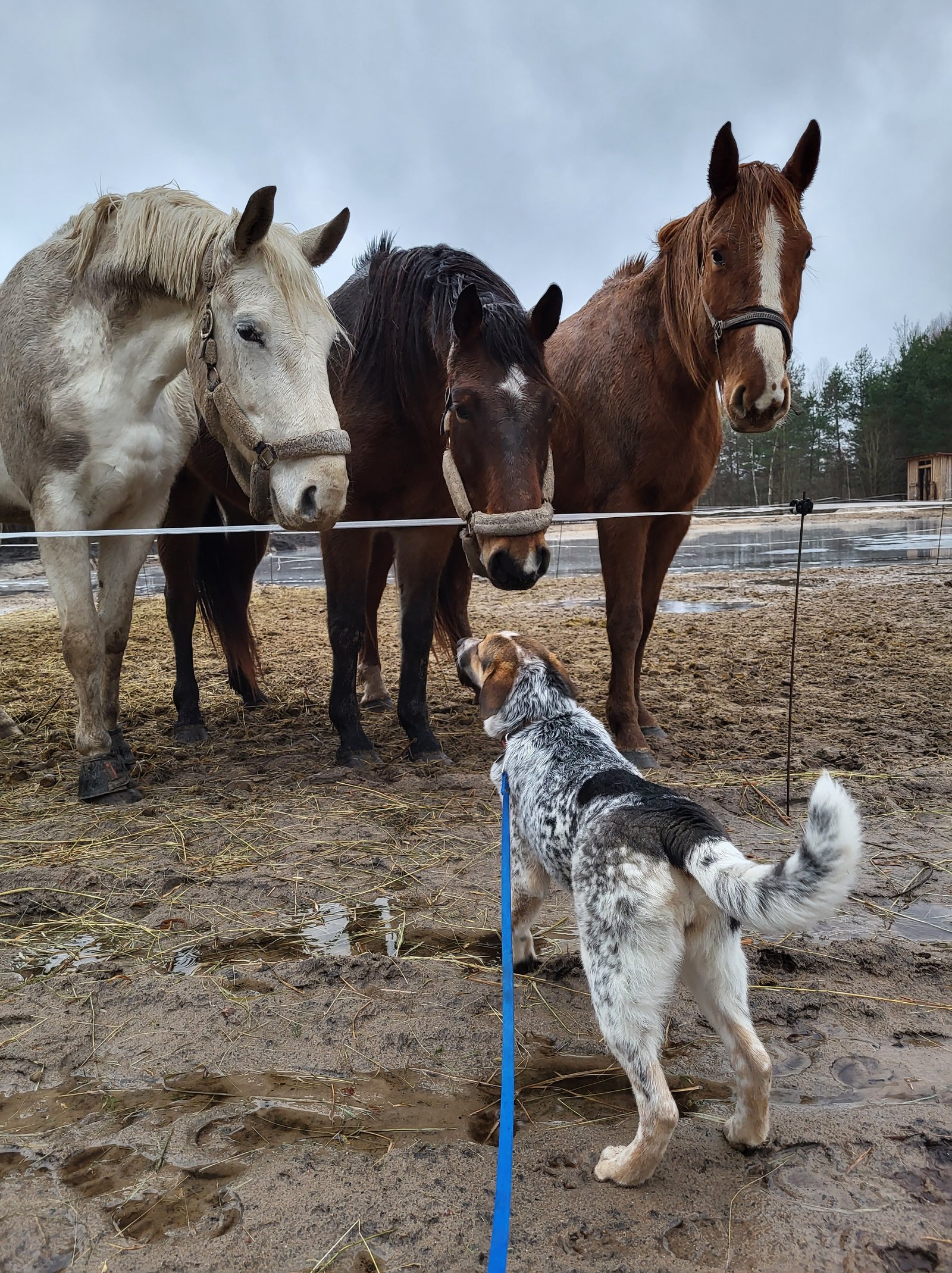
- Farming-related Therapy: Involves working with crops, often in a community setting.
- Animal-assisted Therapy: Includes playing, communicating with, or training horses or dogs for therapeutic purposes.
- Adventure Therapy: Features activities like white water rafting or rock climbing for therapeutic outcomes.
- Wilderness Therapy: Aids groups, especially teens and young adults with behavioral issues, often incorporating hikes of varying durations.
- Forest Therapy (Forest Bathing): A mindful practice where individuals use their five senses while walking through a forest.
- Horticultural Therapy: Utilizes plants and plant-based activities for human healing and rehabilitation.
Less Formalized Approaches:
- Green Exercises: Physical activities in nature, such as walking, running, swimming, yoga, and other exercises.
- Art, Music, and Dance in Nature: Expressive activities conducted outdoors.
- Nature Therapy Methods: Practices in nearby parks or nature spaces, including journaling, drawing, writing, meditation, grounding, photography, reflecting, etc.
- Ecotherapy Indoors: Activities that can be practiced at home, involving care for plants and pets, among other practices.
- Ecotherapeutic Lifestyle: A way of life that incorporates regular practices and activities related to ecotherapy at different levels.
- Different Levels of Ecotherapy: Can be practiced at Level 1 and Level 2, either solo or with others, and within various social circles (family, work, community, etc.).
Closing Reflection: Nurturing Bonds with Nature
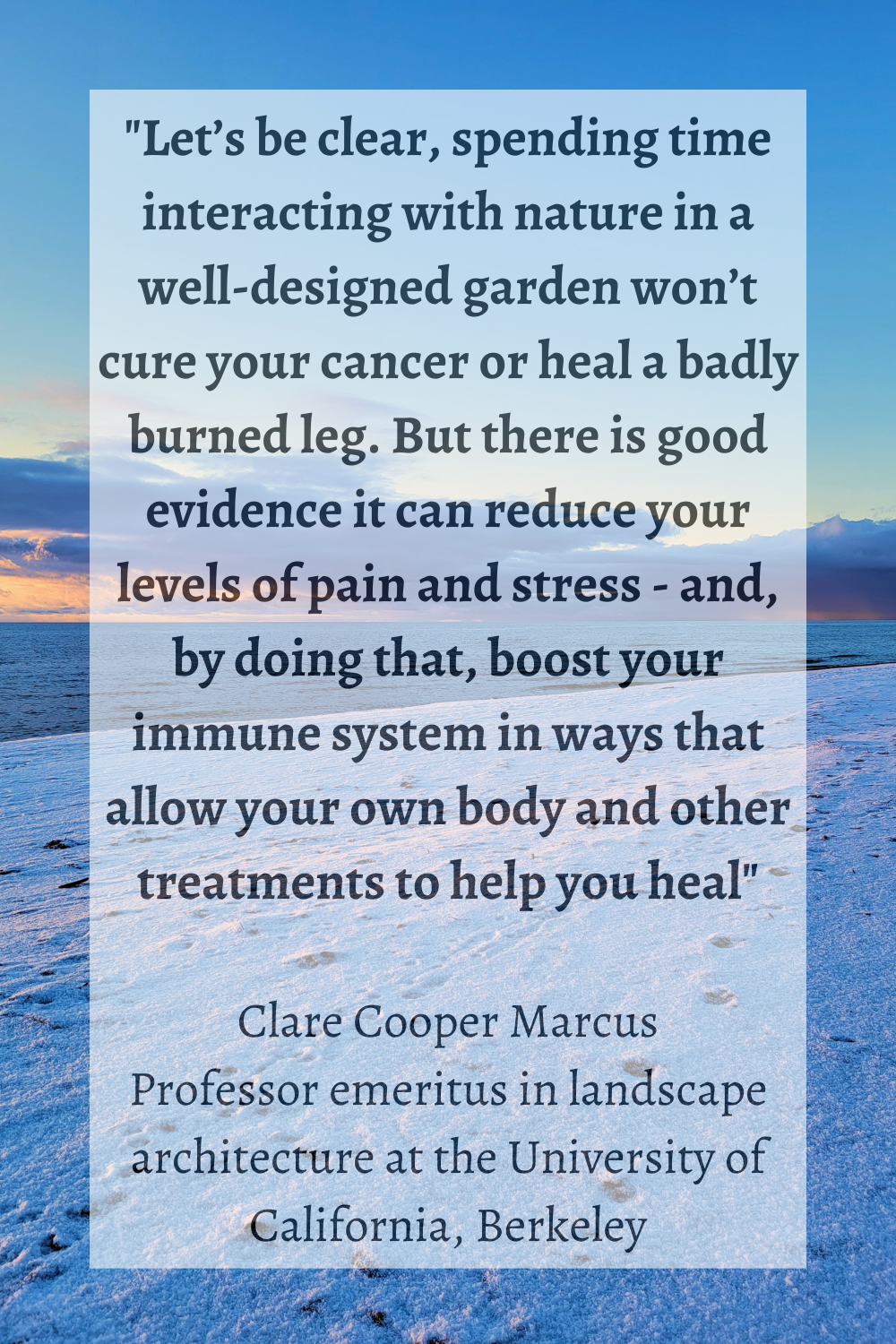
Clare Cooper Marcus, professor emeritus, rightly asserts that nature won’t miraculously cure major ailments, but it possesses the profound ability to ease our pain and stress, fortifying our immune system for healing. I agree and believe that science has only scratched the surface of nature’s mysteries. Our connection and care for nature can be the catalyst for improved mental and physical health, granting us the strength and wisdom needed to care for both our planet and one another. Amidst the scientific complexities, one thing is clear – nature is a true ally to our health. Now is the moment for a collective shift in mindset, a commitment to care for nature as we would for a dear friend.
Dear Reader, I sincerely appreciate your time and commitment to this exploration. Your involvement lays the groundwork for actions that can hold significant meaning. Pause for reflection, allow fresh ideas to take root, plan, and engage in activities that will strengthen your bond with nature. Today is a great day to join this shared journey of care.
See You soon and let nature’s wisdom accompany you,
Karina
References
- Bressane, A., Negri, R.G., de Brito Junior, I., Medeiros, L.C.d.C., Araújo, I.L.L., Silva, M.B., Galvão, A.L.d.S., Rosa, G.C.S.d. (2022). Association between Contact with Nature and Anxiety, Stress and Depression Symptoms: A Primary Survey in Brazil, 14, 10506. https://doi.org/10.3390/su141710506.
- Buzzell, L (2016). Chapter 5: The Many Ecotherapies (2016) in M. Jordan & J. Hinds (Eds.) Ecotherapy: Theory, Research & Practice.
- Chaudhury, P., & Banerjee, D. (2020). “Recovering With Nature”: A Review of Ecotherapy and Implications for the COVID-19 Pandemic. Frontiers in public health, 8, 604440. https://pubmed.ncbi.nlm.nih.gov/33363096/
- Clinebell, (1996). Ecotherapy: Healing ourselves, healing the Earth. Minneapolis: Fortress Press.
- Conn, S. A. (2010). “Living in the earth: Ecopsychology, health, and psychotherapy”. The Humanistic Psychologist. 26 (1–3): 179–198. https://doi.org/10.1080/08873267.1998.9976972
- Delaney, M. E. (2020). Nature is nurture: Counseling and the natural world. (D. G. Zebrowski, R. K. Talpady, S. I. Springer, E. McCauley, M. Sheklian, B. Sheridan, J. T. Duffy, M. Brumber, C. Brosch, N. M. A. Sanders, K. Forziat-Pytel, B. Lichter, J. Jodry, M. Reid, J. Colucci, M. Hogan, J. Yellowhair, J. E. Schwarz & K. Huber, Contributors). Oxford University Press.
- Diette G.B., Lechtzin N., Haponik E., Devrotes A., Rubin H.R. (2003). Distraction therapy with nature sights and sounds reduces pain during flexible bronchoscopy: a complimentary approach to routine analgesia. Chest. 123:941–8. DOI: 10.1378/chest.123.3.941
- Doherty, T.J. (2016). Chapter 1: Theoretical and Empirical Foundations for Ecotherapy (2016) in M. Jordan & J. Hinds (Eds.) Ecotherapy: Theory, Research & Practice. https://www.researchgate.net/publication/316529575_Theoretical_and_Empirical_Foundations_for_Ecotherapy
- Ewert, A., & Chang, Y. (2018). Levels of Nature and Stress Response. Behavioral sciences (Basel, Switzerland), 8(5), 49. https://www.ncbi.nlm.nih.gov/pmc/articles/PMC5981243/
- Fisher, A. (2012). Radical ecopsychology: Psychology in the service of life. New York: Albany State University of New York Press.
- Han, J. W., Choi, H., Jeon, Y. H., Yoon, C. H., Woo, J. M., & Kim, W. (2016). The Effects of Forest Therapy on Coping with Chronic Widespread Pain: Physiological and Psychological Differences between Participants in a Forest Therapy Program and a Control Group. International journal of environmental research and public health, 13(3), 255. doi: 10.3390/ijerph13030255
- Jimenez, M. P., DeVille, N. V., Elliott, E. G., Schiff, J. E., Wilt, G. E., Hart, J. E., & James, P. (2021). Associations between Nature Exposure and Health: A Review of the Evidence. International journal of environmental research and public health, 18(9), 4790. https://doi.org/10.3390/ijerph18094790
- Kaplan S. (1995). The Restorative Benefits of Nature: Toward an Integrative Framework. Journal of Environmental Psychology 16, 169-182. https://doi.org/10.1016/0272-4944(95)90001-2
- McGeeney A. (2016). With Nature in Mind: The Ecotherapy Manual for Mental Health Professionals. London; Philadelphia, PA: Jessica Kingsley Publishers.
- Pritchard, A., Richardson, M., Sheffield, D. et al. (2020). The Relationship Between Nature Connectedness and Eudaimonic Well-Being: A Meta-analysis. J Happiness Stud 21, 1145–1167. https://link.springer.com/article/10.1007/s10902-019-00118-6
- Rogers, K. (2023). Biophilia hypothesis. Encyclopedia Britannica. https://www.britannica.com/science/biophilia-hypothesis
- Roszak, T. (1992). Voice of the Earth – an exploration of Ecopsychology. Grand Rapids, MI: Phanes Press.
- Roszak, T., Gomes, M. E., & Kanner, A. D. (Eds.). (1995). Ecopsychology: Restoring the earth, healing the mind. Sierra Club Books.
- Schertz, K. E., & Berman, M. G. (2019). Understanding Nature and Its Cognitive Benefits. Current Directions in Psychological Science, 28(5), 496-502. https://doi.org/10.1177/0963721419854100
- Ulrich, R. S. (1984). View through a window may influence recovery from surgery. Science, 224(4647), 420-421. DOI:10.1126/science.6143402
- Yang, Y., Sedikides, C., Wang, Y., & Cai, H. (2023). Nature Nurtures Authenticity: Mechanisms and Consequences. Journal of Personality and Social Psychology. Advance online publication. https://dx.doi.org/10.1037/pspi0000432
- Wenfei Y., Xiaofeng Z., & Qi G. (2021). The effect of exposure to the natural environment on stress reduction: A meta-analysis. Urban Forestry & Urban Greening, 57. https://doi.org/10.1016/j.ufug.2020.126932
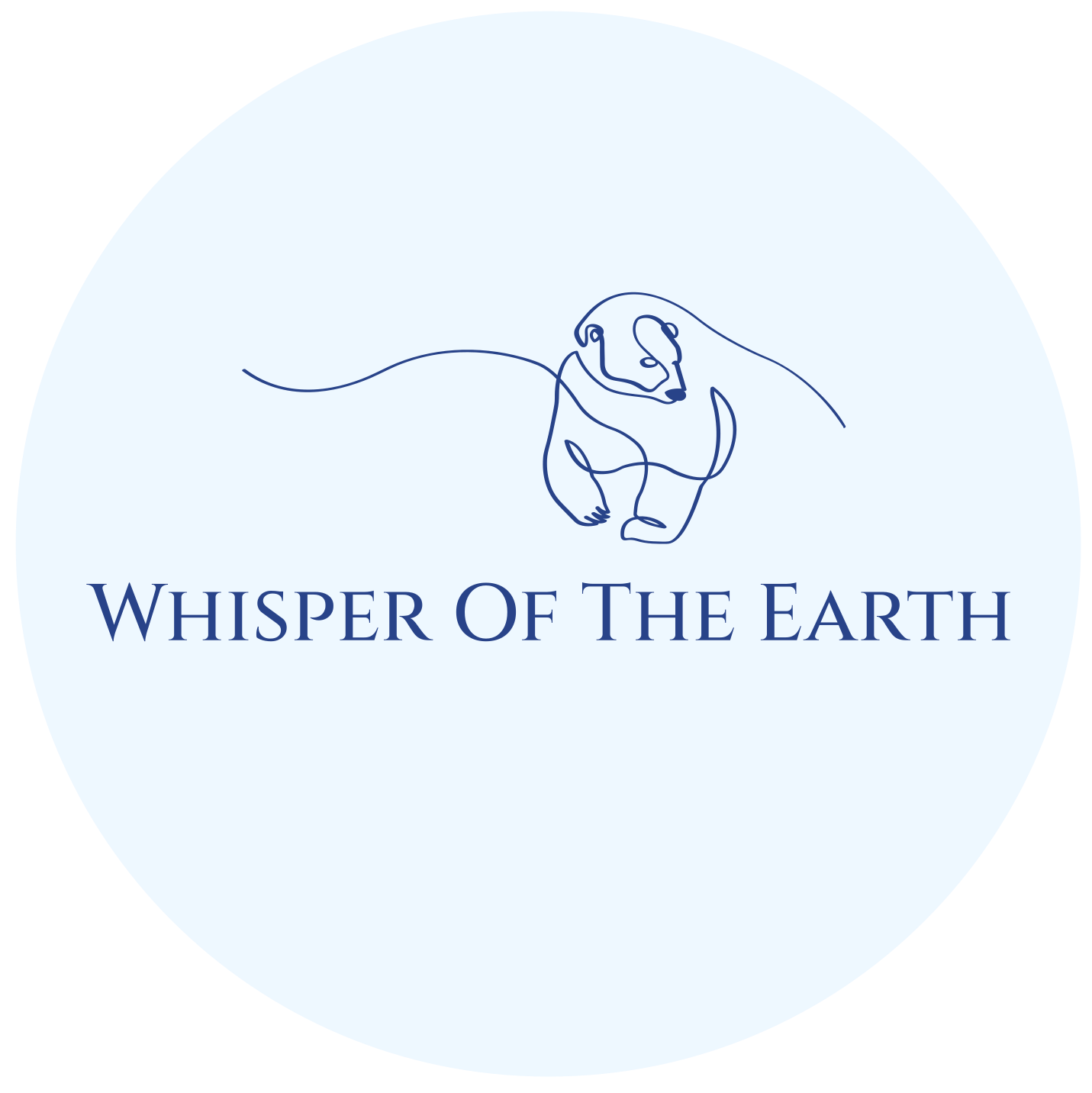




Leave a Reply